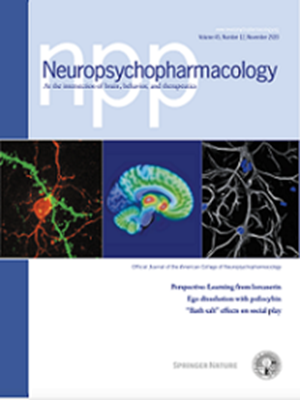Circulating endocannabinoids in children and adolescents: associations with anxiety and the impact of selective serotonin reuptake inhibitors
IF 6.6
1区 医学
Q1 NEUROSCIENCES
引用次数: 0
Abstract
Anxiety disorders are prevalent psychiatric conditions that frequently emerge during adolescence. Among the neurobiological systems implicated in these disorders, the endocannabinoid (eCB) signaling system plays a crucial role, making it a promising target for therapeutic interventions. In addition to its direct effects on anxiety regulation, eCBs may also influence response to first-line pharmacologic treatments, such as selective serotonin reuptake inhibitors (SSRIs). However, little is known about developmental changes in eCB lipids—N-arachidonoylethanolamide (AEA) and 2-arachidonoylglycerol (2-AG)—or their relationship to anxiety symptoms and treatment response. Circulating AEA and 2-AG concentrations were measured in youth (aged 9–17, N = 199) with varying anxiety symptoms, assessed using the Screen for Child Anxiety-Related Disorders (SCARED). We evaluated how eCBs relate to developmental factors (e.g., demographics, biological variables) and anxiety symptoms (SCARED total). Additionally, we examined how eCB concentrations change in response to acute SSRI treatment in a subsample of adolescents (age 12–17, N = 41) with generalized anxiety disorder (GAD), who participated in an 8-week randomized placebo-controlled trial of escitalopram (15 mg/day, titrated to 20 mg/day). Body mass index (BMI) was positively correlated with circulating AEA, while 2-AG showed negative associations with age, female sex, and time-of-day. After adjusting for these variables, more severe anxiety symptoms were associated with higher AEA and lower 2-AG. Greater increases in 2-AG from baseline (without changes in AEA) were linked to improved treatment response in adolescents with GAD. Our study suggests that circulating eCBs may serve as biomarkers for anxiety severity and predictors of treatment response in youth. ClinicalTrials.Gov Identifier: NCT02818751.

儿童和青少年循环内源性大麻素:与焦虑和选择性血清素再摄取抑制剂的影响有关。
焦虑症是青少年时期常见的精神疾病。在与这些疾病相关的神经生物学系统中,内源性大麻素(eCB)信号系统起着至关重要的作用,使其成为治疗干预的有希望的靶点。除了对焦虑调节的直接作用外,eCBs还可能影响对一线药物治疗的反应,如选择性5 -羟色胺再摄取抑制剂(SSRIs)。然而,关于eCB脂质- n -花生四烯酰基乙醇酰胺(AEA)和2-花生四烯酰基甘油(2-AG)-的发育变化或它们与焦虑症状和治疗反应的关系知之甚少。在有不同焦虑症状的青少年(9-17岁,N = 199)中测量循环AEA和2-AG浓度,使用儿童焦虑相关障碍筛查(SCARED)进行评估。我们评估了脑电图与发育因素(如人口统计学、生物学变量)和焦虑症状(总惊恐指数)的关系。此外,我们在患有广泛性焦虑症(GAD)的青少年亚样本(12-17岁,N = 41)中研究了eCB浓度在急性SSRI治疗后的变化,他们参加了一项为期8周的艾司西酞普兰随机安慰剂对照试验(15 mg/天,滴定至20 mg/天)。身体质量指数(BMI)与循环AEA呈正相关,而2-AG与年龄、女性性别和时间呈负相关。在对这些变量进行调整后,更严重的焦虑症状与较高的AEA和较低的2-AG相关。2-AG较基线的较大增加(没有AEA的变化)与GAD青少年治疗反应的改善有关。我们的研究表明,循环eCBs可以作为青少年焦虑严重程度的生物标志物和治疗反应的预测因子。
本文章由计算机程序翻译,如有差异,请以英文原文为准。
求助全文
约1分钟内获得全文
求助全文
来源期刊

Neuropsychopharmacology
医学-精神病学
CiteScore
15.00
自引率
2.60%
发文量
240
审稿时长
2 months
期刊介绍:
Neuropsychopharmacology is a reputable international scientific journal that serves as the official publication of the American College of Neuropsychopharmacology (ACNP). The journal's primary focus is on research that enhances our knowledge of the brain and behavior, with a particular emphasis on the molecular, cellular, physiological, and psychological aspects of substances that affect the central nervous system (CNS). It also aims to identify new molecular targets for the development of future drugs.
The journal prioritizes original research reports, but it also welcomes mini-reviews and perspectives, which are often solicited by the editorial office. These types of articles provide valuable insights and syntheses of current research trends and future directions in the field of neuroscience and pharmacology.
 求助内容:
求助内容: 应助结果提醒方式:
应助结果提醒方式:


